Want better sound? Using a highpass filter is an excellent way to get better sound quality and performance from even budget speakers.
In this article I’ll share what you need to know plus you’ll learn the basics of crossovers and why they matter.
Contents
What is a low pass (LPF) or high pass (HPF) filter?
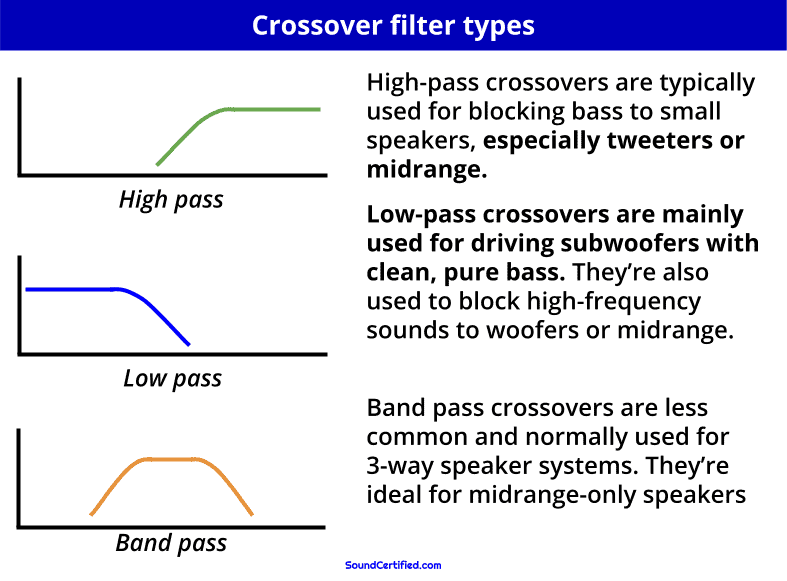
High pass filter vs low pass filter differences
A highpass filter (HPF) works to block unwanted frequencies in the audio signal output (low frequency sounds) below the crossover point from reaching a speaker. Everything above the crossover point will be allowed to pass.
Likewise, a low pass filter (LPF) blocks high frequency sounds above the cutoff frequency. A low pass crossover is typically used for subwoofers but can also be used with a higher frequency setting for 2-way speaker settings to block treble to a woofer or as part of a 3-way system as well.
This is true for crossovers built into a home receiver, home or car amplifier, or a modern car stereo. Speaker crossovers do the same thing but they use capacitors and inductors instead of electronic circuits to accomplish this.
When should I use a high pass filter?
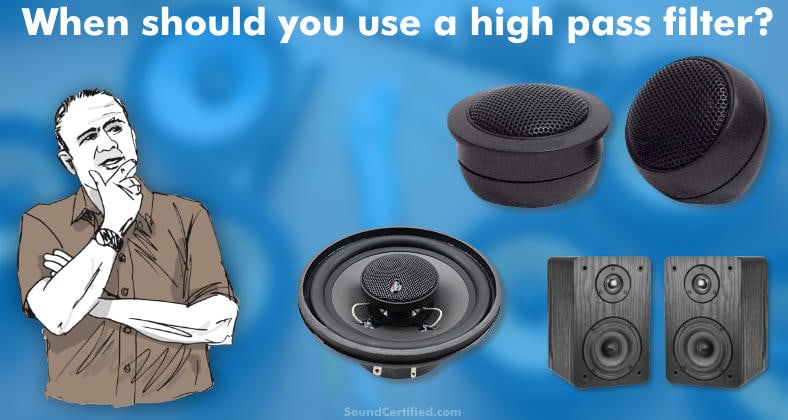
High pass filters are extremely helpful in some cases and more of a “nice to have” option in others – it depends on your particular speaker system.
Basically, you should use a high pass filter when:
- You’re using tweeters without a crossover or the included crossover isn’t good enough (see the crossover slope section below for more info).
- In a car audio system where you’d like more volume & clarity from small speakers, preventing distortion & “bottoming out” due to heavy bass they can’t produce well.
- For a home audio system where you’re using a subwoofer and would like to prevent excessive bass. This is helpful when using a powered subwoofer alongside your main speakers to avoid having too much bass.
- Bi-amping: removing a passive crossover (speaker crossover) to drive the speakers directly from amplifier channels one speaker per channel.
- Preventing bass from reaching small or rear surround home stereo speakers that can’t produce deep bass.
When it comes to tweeters, it’s especially critical to prevent them from being driven with low bass frequencies. Similar can be said for many types of midrange speakers as well. They can’t handle the frequency range of some musical content like bass notes.
It causes distortion and can even damage them permanently if driven hard enough. Bass frequencies require a large speaker cone to produce that range of sound which isn’t possible with the tiny cone or dome they have.
What should I set my high pass filter to?
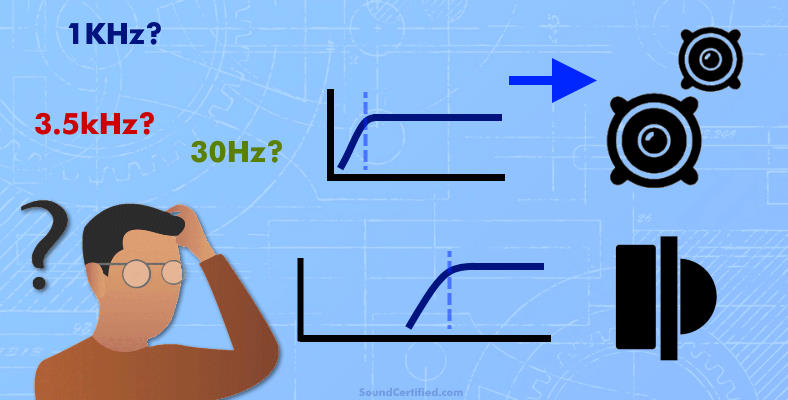
It can be confusing at first but once you get a bit of experience with speakers it becomes a little bit easier thank goodness! In the sections below I’ll simplify the HPF frequency you should use for each case as well as provide some notes to help explain why it matters.
1. Speaker manufacturer recommendations

Manufacturers often include specifications that will tell you the cutoff frequency to use. Sometimes this is clearly stated as the recommended cutoff while other times you’ll have to base it off of a speaker’s frequency response information. For example, in the image above we can see that the tweeter has a usable frequency range of 3.5kiloHertz (kHz) and above.
If neither are provided you can use the tables below. The good news is that there’s usually some information to tell you a speaker’s frequency response range that you can set the high-pass filter by.
2. Home audio high pass crossover frequency table
| Speaker type/system | Crossover frequency |
|---|---|
| Main/tower type front speakers (small) | 60 to 80 Hz high-pass. Works best with a subwoofer to complement them. |
| Main/tower type front speakers (large) | 60-80Hz high-pass. |
| Center or surround sound (small) | 100-120Hz high pass. These types of speakers are very poor for bass and can distort easily. |
| Center or surround sound (medium/large) | 60-80Hz high pass. Most center speakers are not designed for bass production. |
| On-wall or mini satellite speakers | 100-120Hz high pass. This helps avoid bad distortion since they can’t handle deep bass. |
| 2-way speaker systems | 3kHz to 3.5KHz. Very common crossover frequency |
| 3-way speaker systems | 3.5kHz high pass (tweeter) & 250-500Hz high pass (midrange) |
| Subwoofer subsonic filter | 20-30Hz high pass. Useful for vintage audio like vinyl records to block rumble & power-wasting signals. |
You can pick a good crossover frequency from the table above as they’re some of the most commonly used.
Home stereo satellite or rear speaker use
One thing to note is that it’s common for home stereo rear or satellite speakers (like surround sound speakers) to be a bit weak and unable to handle deep bass due to small speaker drivers and a poor enclosure. It’s one reason they sound bad during heavy sound moments like surround sound audio in movies or hard-thumping music.
This is especially true of home-theater-in-a-box systems that use simple & inexpensive rear speakers with a single cone.
3. Car audio high pass crossover frequency table
| Speaker type/system | Crossover frequency |
|---|---|
| Front or rear full-range coaxials or component speakers | 56, 60, to 80 Hz high pass. Blocks low end bass that causes distortion. |
| Tweeters | 3-3.5kHz high pass |
| Midrange or woofer speakers | 250-500Hz high pass |
| 2-way speaker systems | 3kHz to 3.5KHz to tweeters. Same for midrange/woofers |
| 3-way speaker systems | 3.5kHz (mid/treble) & 500Hz (mid/woofer) |
| Subwoofer subsonic filter | 20-30Hz high pass. Helpful when you’re dealing with audio power-wasting bass frequencies due to certain audio tracks or equipment. |
Car audio systems are often susceptible to bad sound, distortion, and “bottoming out” during bass-heavy music and especially under high power. Bottoming out is when a speaker voice coil assembly is forced to its limit during heavy bass and touches the speaker magnet because it’s being pushed to its limits and beyond when trying to produce bass notes.
How they help you get better sound
This is a pretty common problem. For example, when coaxial speakers are mounted in a dashboard or doors without a good enclosure the open-air condition means there’s little opposition to the speaker cone (no backpressure).
This allows the cone to move too easily, creating noise, distortion, and even damage in some cases. That’s especially true if you’re using a bass boost feature – sometimes you’ll hear distortion immediately.
High pass filters can prevent this entirely! It also has another benefit: you can drive your speakers to their power limit with great sound clarity and volume. This helps you get the most from even budget speakers when done right.
What crossover slope should I use?
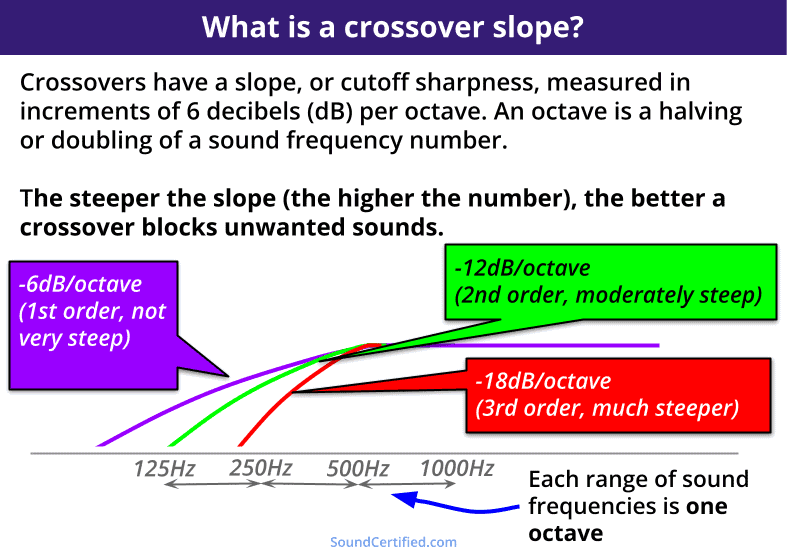
What is a crossover slope?
The slope is the steepness of a crossover’s filtering ability. In other words, it’s how effective it is at blocking sound past the crossover’s cutoff point.
Slopes are described in terms of decibels (dB) per octave, written as “dB/octave.” A negative symbol (-) is used to show they represent an attenuation, or reduction, of the signal beyond the cutoff point.
In audio, we often measure a range of sound frequencies between two points using an octave. One octave is a doubling or halving of a frequency number. (100Hz, 200Hz, 400Hz, etc.)
When we refer to a crossover having a cutoff of -6dB per octave, we mean it will continue to reduce the output by an additional 6dB for every doubling of the previous frequency.
Example: -6dB @ 1KHz, -12dB @ 2KHz, -18dB @ 4KHz, -24dB @ 8KHz, -32dB @ 16KHz, up to 20KHz.
What slope filter setting should I use?
Generally speaking, a -12dB slope is often the best choice and works well for most speaker systems. To block bass to small speakers or tweeters, I recommend at least a 12dB or even better an 18dB slope if you have that option.
The most commonly used slopes are:
- -6dB – typical for inline high pass filters to cheap tweeters, but not so good at blocking unwanted sounds.
- -12dB – Much better and one of the most common you’ll find.
- -18dB – Especially effective at blocking.
Electronic crossovers (especially for a car amp) are typically -12dB. Not all offer additional settings but when they do it’s often worth experimenting with them to see how it sounds for your audio system.
Can I use a high pass filter with speakers that already have crossovers?
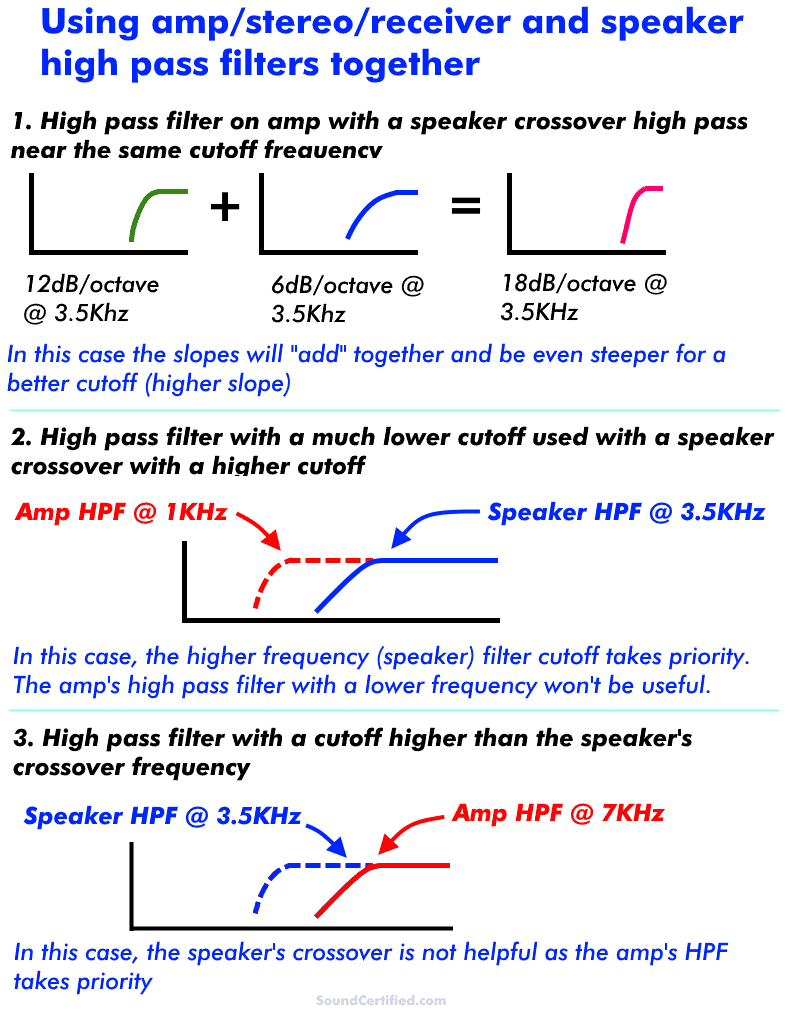
Yes, you sure can in most cases! In fact, while generally not necessary, it can be helpful in some cases.
When using a stereo, amplifier, or receiver’s built-in crossover it will work in addition to the speaker crossover already in use. In many cases, you’ll get a steeper slope (better blocking) than either one alone.
For example, when using an amp’s 12dB HPF crossover at 3.5KHz with a tweeter with a 6dB @ 3.5KHz crossover capacitor in place, they’ll effectively add together and give you an 18dB slope – a steeper & more effective cutoff than you’d get otherwise.
There are a few important points to clarify, however:
- If the HPF cutoff frequency is close to that of the speaker crossover, their slopes will basically add together.
- If the HPF cutoff of the amp is much lower than that of the speaker’s crossover, it won’t be as helpful (or could even be useless). The speaker’s crossover will take priority.
- If the HPF is much higher than that of the speaker crossover, the speaker crossover will be effectively ignored since it won’t come into play in that case. The amp’s HPF will take priority in that case.
Optionally you can remove a speaker crossover completely if you’re working on an audiophile-level project. This is because crossover components (capacitors and inductors) introduce a problem called phase shift which an electronic crossover does not.
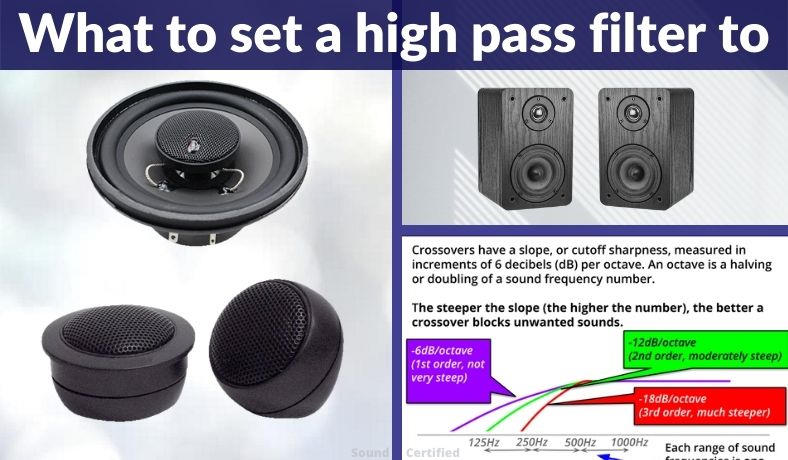

Hi Marty,
Here is my issue. I am currently running a kenwood 400 watt amp on my Harley with 2 Kicker 4 inch enclosed speakers mounted on my handle bars. I am considering adding 2 5.25 Kicker speakers mounted to my engine crash bars, the amp has the option to use high pass filter on one set of speakers and low pass on a second set. Just wondering if with my proposed 4 speaker setup would those filters actually make a difference.? If they would, how should I set them up? Not a sound guy, just like my music to sound good on a very limited budget. Any info or suggestions would be great
Thanks
Mike
Hi Mike what model amplifier is it?
Using a high-pass crossover can help, yes, to block low bass from small speakers. That way you can get more volume without distortion that would otherwise be there due to low-end bass that small speakers cannot handle well.
Generally using a high-pass filter set to around 50-70 Hertz or so works well. If the amp’s rear channels offer *only* a low-pass crossover, then you wouldn’t use it unless you’re using woofers/subwoofers. Best regards!